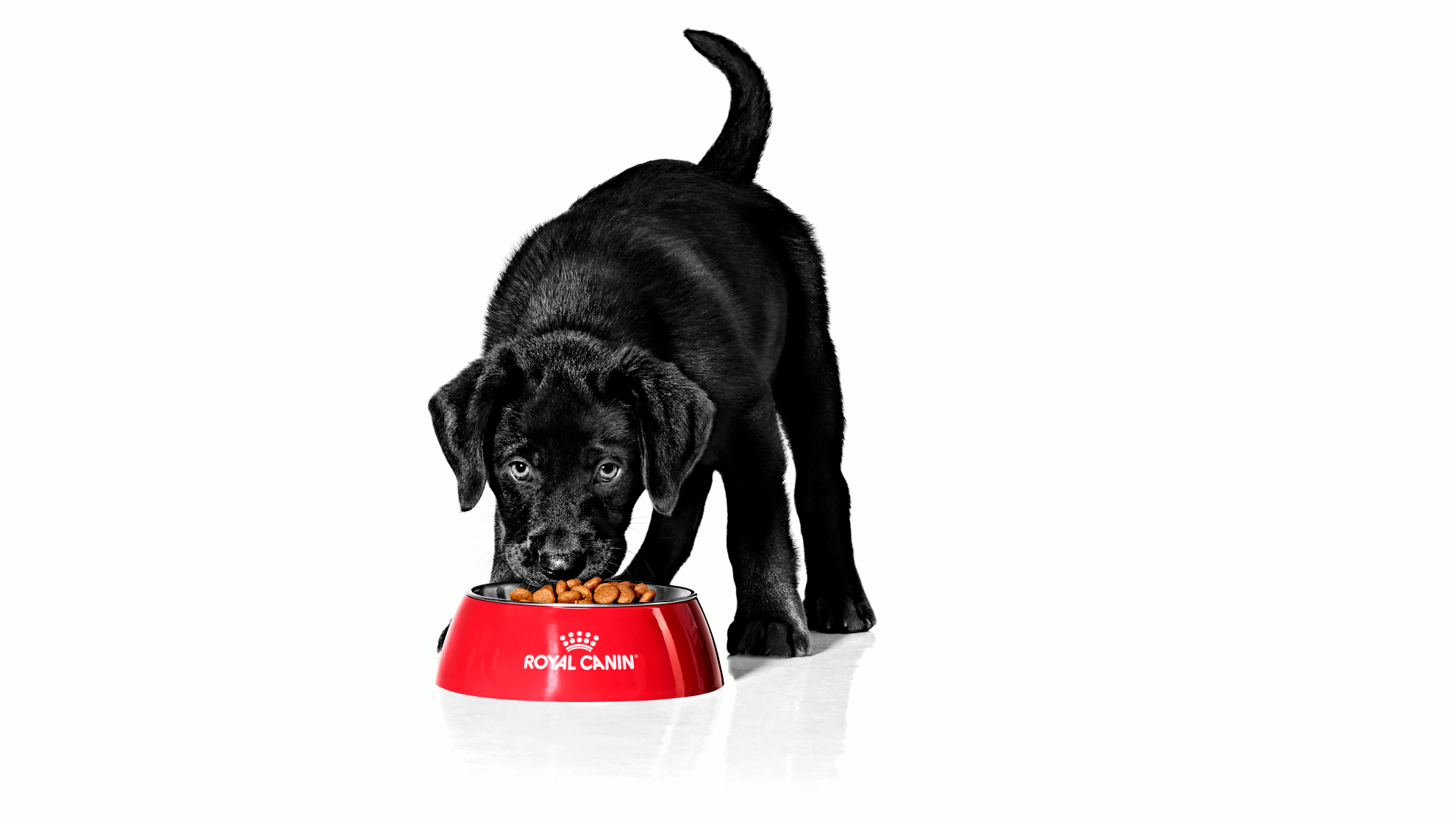How often should you feed a puppy?
You’re not alone with this question. Many new puppy parents wonder how often to feed a puppy. Your puppy's breed and future size dictate their unique nutritional needs. As a pet owner, providing them with a balanced diet—including the correct nutrient balance—is essential. It sets them on the road to a healthy adulthood, supporting both their physical growth and brain development. Brushing up on the basics of puppy feeding and nutrition will help you take the best care of your new puppy.


All you need to know about your puppy’s development
Puppies grow differently depending on their breed and how big that breed will be in adulthood. But all puppies share similar stages of development in their first months. Their bodies are busy developing physically and cognitively while they learn the social skills they’ll need in their new position as your family dog.
During all stages of puppyhood, nutrition, exercise and sleep are essential for their physical and mental health.
Newborn to 4 weeks, the neonatal stage
Your puppy came into the world without the ability to see, hear or smell, relying entirely on their mum for all their physical and nutritional needs. They spend most of their time sleeping, crawling to their mother for nourishment, warmth and protection using only their taste and touch senses.
Weeks two through four begin the transformation from a helpless puppy to a clumsy one. As their senses develop, their eyes open, letting them see their surroundings. They don’t see well until eight weeks, so everything is blurry. Their ear canals will also open, allowing them to hear. Your puppy uses these new senses to interact with their mother and littermates.
By week four, your puppy can walk but will be gawky. They start to bark, wag their tail and can take care of their toilet needs independently. During this time, the baby or milk teeth emerge. Puppy teeth are very sharp and can be uncomfortable for their mother, so she will begin the gradual weaning process.
While the puppies are transitioning to solid foods, mother’s milk decreases and the puppies lose lactose tolerance. They enter ‘the immunity gap’, meaning their immune system is not mature enough to protect them from disease, while the immunity coming from colostrum is declining. Puppy vaccinations give some of the protection they need.
4 to 8 weeks, the fearless puppy
During this period, your puppy will complete weaning and be an independent eater. They interact more with their siblings and mother, starting the learning curve of puppy etiquette, such as the difference between biting to hurt and biting to play.
At this age, puppies have a high fear threshold—they are close to fearless. This is the time to gradually, and with loads of positive reinforcement, start introducing them to different environments, sights, sounds and people. Be careful about introducing them to other healthy and friendly animals unless your puppy is fully vaccinated. Socialisation is a crucial part of puppy development.
Your puppy is mature enough to go to their permanent family from eight weeks onward.
8 to 12 weeks, your little sponge
During this period, skeletal development works hard to support your growing puppy. Complete puppy food that contains adequate amounts of calcium and phosphorus support skeletal growth. Supplements are unnecessary. A supplement will do more harm than good if your pup is on quality food. Large breeds have different nutritional needs than smaller breeds because they carry more muscle and heavier bones and have a longer growing period.
Your puppy will be a sponge, eager to explore new experiences. Positive reinforcement training, loads of praise and tasty treats build your puppy’s confidence and sense of security, which is a good thing because the fearless period doesn’t last. When introducing an unfamiliar experience, observing before participation reduces the risk of your puppy becoming frightened.
Around 10-12 weeks, your puppy may come into a fearful or wary stage of development. It doesn’t last long either but watch your puppy for signs of fear or anxiety and be ready to step in with pet-parent comforting skills.
Your puppy is forming solid bonds with their people, developing a lifetime relationship. Puppy socialisation and basic training can begin during this life stage.
12 to 24 weeks, the pre-adolescent puppy
Your puppy’s skeleton is still developing, requiring the correct amount of calcium and phosphorus. Too much calcium can cause skeletal deformities. Complete quality puppy foods have the proper amount puppies need.
Your puppy has a lot to figure out about life right now. The fearful stage passes at ten weeks, and puppies become curious enough to explore their surroundings more independently. They’re learning the pecking order of both family and other pets. Personality traits become apparent.
The best part of this age is puppy vocalisations. Your puppy will try out their barking skills, emitting fierce puppy growls and, if you’re lucky, a howl or two! Of course, this may vary according to the breed.
Baby or milk teeth will fall out as the permanent teeth come in. Toys and chews of different textures and cooled teething toys can soothe teething discomfort and save your personal items.
Socialisation is essential right now. Taking your vaccinated puppy for walks around the neighbourhood provides an opportunity for some quality sniffing action. Controlled interactions with other vaccinated dogs, introducing a variety of new experiences, sights and sounds help build a confident adult dog.
6 to 12 months, the adolescent dog
Adolescent puppies will test boundaries and try to assert themselves in the pack or family. They have a low boredom threshold and need regular mental and physical exercise. Training through play is an effective way to teach basic commands and skills.
Your puppy will reach sexual maturity during this stage. Spaying or neutering puppies changes their nutritional needs. Puppies who have been spayed or neutered require less energy—aka calories—to maintain their correct weight. Enlist the help of your vet if you notice your puppy gaining excess weight.
At seven months, your puppy is still building muscle mass and needs easily digestible, high-quality proteins to support that muscle development.
At 10 months, small breeds are nearing their adult size. Larger breeds reach their adult size between 15 and 24 months. Large breeds put more load on their skeletons due to larger bones and muscle mass. They should remain on puppy food formulated for large breeds to support joints while muscle mass builds.
When your puppy has reached adulthood, feed them adult food that maintains their weight without adding excess calories and supports their nutritional needs as they age.
Newborn to 4 weeks, the neonatal stage
Your puppy came into the world without the ability to see, hear or smell, relying entirely on their mum for all their physical and nutritional needs. They spend most of their time sleeping, crawling to their mother for nourishment, warmth and protection using only their taste and touch senses.
Weeks two through four begin the transformation from a helpless puppy to a clumsy one. As their senses develop, their eyes open, letting them see their surroundings. They don’t see well until eight weeks, so everything is blurry. Their ear canals will also open, allowing them to hear. Your puppy uses these new senses to interact with their mother and littermates.
By week four, your puppy can walk but will be gawky. They start to bark, wag their tail and can take care of their toilet needs independently. During this time, the baby or milk teeth emerge. Puppy teeth are very sharp and can be uncomfortable for their mother, so she will begin the gradual weaning process.
While the puppies are transitioning to solid foods, mother’s milk decreases and the puppies lose lactose tolerance. They enter ‘the immunity gap’, meaning their immune system is not mature enough to protect them from disease, while the immunity coming from colostrum is declining. Puppy vaccinations give some of the protection they need.
4 to 8 weeks, the fearless puppy
During this period, your puppy will complete weaning and be an independent eater. They interact more with their siblings and mother, starting the learning curve of puppy etiquette, such as the difference between biting to hurt and biting to play.
At this age, puppies have a high fear threshold—they are close to fearless. This is the time to gradually, and with loads of positive reinforcement, start introducing them to different environments, sights, sounds and people. Be careful about introducing them to other healthy and friendly animals unless your puppy is fully vaccinated. Socialisation is a crucial part of puppy development.
Your puppy is mature enough to go to their permanent family from eight weeks onward.
8 to 12 weeks, your little sponge
During this period, skeletal development works hard to support your growing puppy. Complete puppy food that contains adequate amounts of calcium and phosphorus support skeletal growth. Supplements are unnecessary. A supplement will do more harm than good if your pup is on quality food. Large breeds have different nutritional needs than smaller breeds because they carry more muscle and heavier bones and have a longer growing period.
Your puppy will be a sponge, eager to explore new experiences. Positive reinforcement training, loads of praise and tasty treats build your puppy’s confidence and sense of security, which is a good thing because the fearless period doesn’t last. When introducing an unfamiliar experience, observing before participation reduces the risk of your puppy becoming frightened.
Around 10-12 weeks, your puppy may come into a fearful or wary stage of development. It doesn’t last long either but watch your puppy for signs of fear or anxiety and be ready to step in with pet-parent comforting skills.
Your puppy is forming solid bonds with their people, developing a lifetime relationship. Puppy socialisation and basic training can begin during this life stage.
12 to 24 weeks, the pre-adolescent puppy
Your puppy’s skeleton is still developing, requiring the correct amount of calcium and phosphorus. Too much calcium can cause skeletal deformities. Complete quality puppy foods have the proper amount puppies need.
Your puppy has a lot to figure out about life right now. The fearful stage passes at ten weeks, and puppies become curious enough to explore their surroundings more independently. They’re learning the pecking order of both family and other pets. Personality traits become apparent.
The best part of this age is puppy vocalisations. Your puppy will try out their barking skills, emitting fierce puppy growls and, if you’re lucky, a howl or two! Of course, this may vary according to the breed.
Baby or milk teeth will fall out as the permanent teeth come in. Toys and chews of different textures and cooled teething toys can soothe teething discomfort and save your personal items.
Socialisation is essential right now. Taking your vaccinated puppy for walks around the neighbourhood provides an opportunity for some quality sniffing action. Controlled interactions with other vaccinated dogs, introducing a variety of new experiences, sights and sounds help build a confident adult dog.
6 to 12 months, the adolescent dog
Adolescent puppies will test boundaries and try to assert themselves in the pack or family. They have a low boredom threshold and need regular mental and physical exercise. Training through play is an effective way to teach basic commands and skills.
Your puppy will reach sexual maturity during this stage. Spaying or neutering puppies changes their nutritional needs. Puppies who have been spayed or neutered require less energy—aka calories—to maintain their correct weight. Enlist the help of your vet if you notice your puppy gaining excess weight.
At seven months, your puppy is still building muscle mass and needs easily digestible, high-quality proteins to support that muscle development.
At 10 months, small breeds are nearing their adult size. Larger breeds reach their adult size between 15 and 24 months. Large breeds put more load on their skeletons due to larger bones and muscle mass. They should remain on puppy food formulated for large breeds to support joints while muscle mass builds.
When your puppy has reached adulthood, feed them adult food that maintains their weight without adding excess calories and supports their nutritional needs as they age.
How often should you feed your puppy?
An important tip about portion sizes: The daily amount recommended by your vet, or the manufacturer should be split between all the daily meals to avoid overfeeding. If you use treats for training, those calories should be taken from your puppy’s daily food portions.
Puppy feeding schedule
If you’re unsure of typical puppy feeding times, here is an example of a four-meal day:
6:00 a.m.
Wake up
6:30 a.m.
Quick walk/exercise
7:00 a.m.
First meal of the day (note the gap between the walk and the meal. Eating too soon can cause bloat in large breed dogs such as Retrievers and German Shepherds. Bloat is a sudden and life threatening swelling of your dog’s stomach. Symptoms are a hard belly that is noticeably swollen and painful to the touch, unproductive vomiting, drooling, restlessness.
11:00 a.m.
Second meal of the day
1:00 p.m.
Afternoon walk/exercise
4:00 p.m.
Third meal of the day
7:00 p.m.
Walk/exercise
9:00 p.m.
Last meal of the day
6:00 a.m.
Wake up
6:30 a.m.
Quick walk/exercise
7:00 a.m.
First meal of the day (note the gap between the walk and the meal. Eating too soon can cause bloat in large breed dogs such as Retrievers and German Shepherds. Bloat is a sudden and life threatening swelling of your dog’s stomach. Symptoms are a hard belly that is noticeably swollen and painful to the touch, unproductive vomiting, drooling, restlessness.
11:00 a.m.
Second meal of the day
1:00 p.m.
Afternoon walk/exercise
4:00 p.m.
Third meal of the day
7:00 p.m.
Walk/exercise
9:00 p.m.
Last meal of the day

How much should you feed your puppy each day?
No matter their breed, puppies have different body types, metabolisms, and nutritional needs. Your veterinarian and the puppy food label all have suggestions on how much to feed your puppy daily. Begin with those suggestions and see how your puppy does. Their body condition should be the indicator of portion control needs. If you notice weight gain, your puppy may be overeating. If they are very lean, their portion may need to increase. Your vet can advise you about your puppy’s body condition. Weighing your puppy regularly and checking the result against growth charts will enable you to feel confident they are on the right path.
Treat or reward-based training methods require adjusting the size of meal portions to accommodate the extra calories in the treats.
Puppy feeding routines and tips
- Feed your puppy at the same time and place each day. Choose a quiet area away from everyday house traffic so your puppy has no distractions. This helps develop healthy eating habits.
- Don’t feed your puppy as soon as you get home. This practice can contribute to mealtime being associated with their relief in your return. Your arrival home is a wonderful opportunity to reconnect with your puppy instead of offering an immediate meal.
- As always, talk to your vet about your puppy’s specific nutritional needs if you have any doubts.
- Supplements are unnecessary if you feed your dog quality puppy food and can cause more harm than good.
- If you’re considering changing your puppy’s food, talk to your veterinarian first to determine which food or nutritional needs your puppy requires. Then transition slowly to avoid digestive upsets.
Food transition schedule
Talk to your vet if your dog has excessive gas or loose stools. You may need to change foods or portion sizes.

Fresh water should be always available. Your puppy’s body can process all the nutrients supporting their rapid growth when their body is well hydrated.
Related articles
Like & share this page